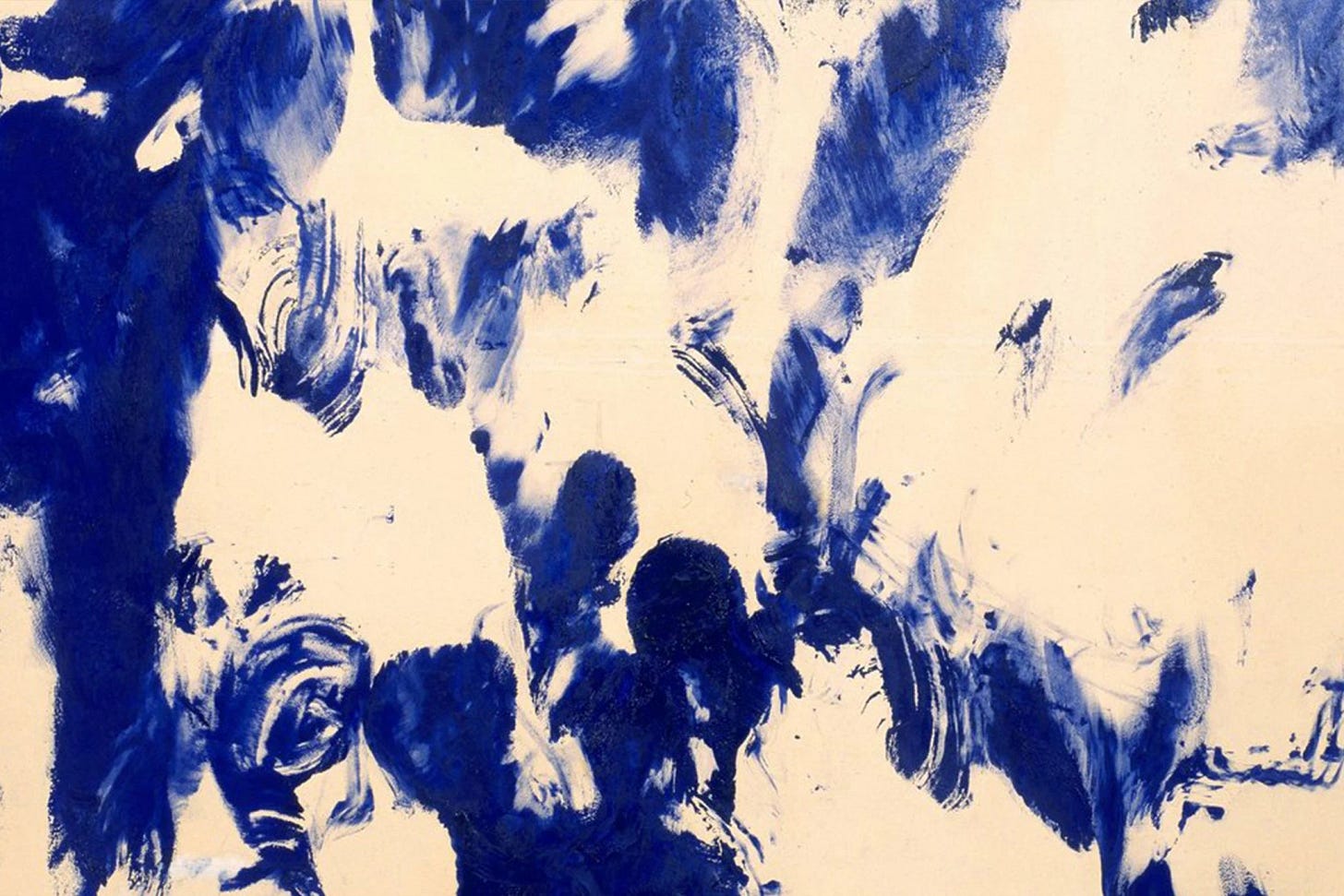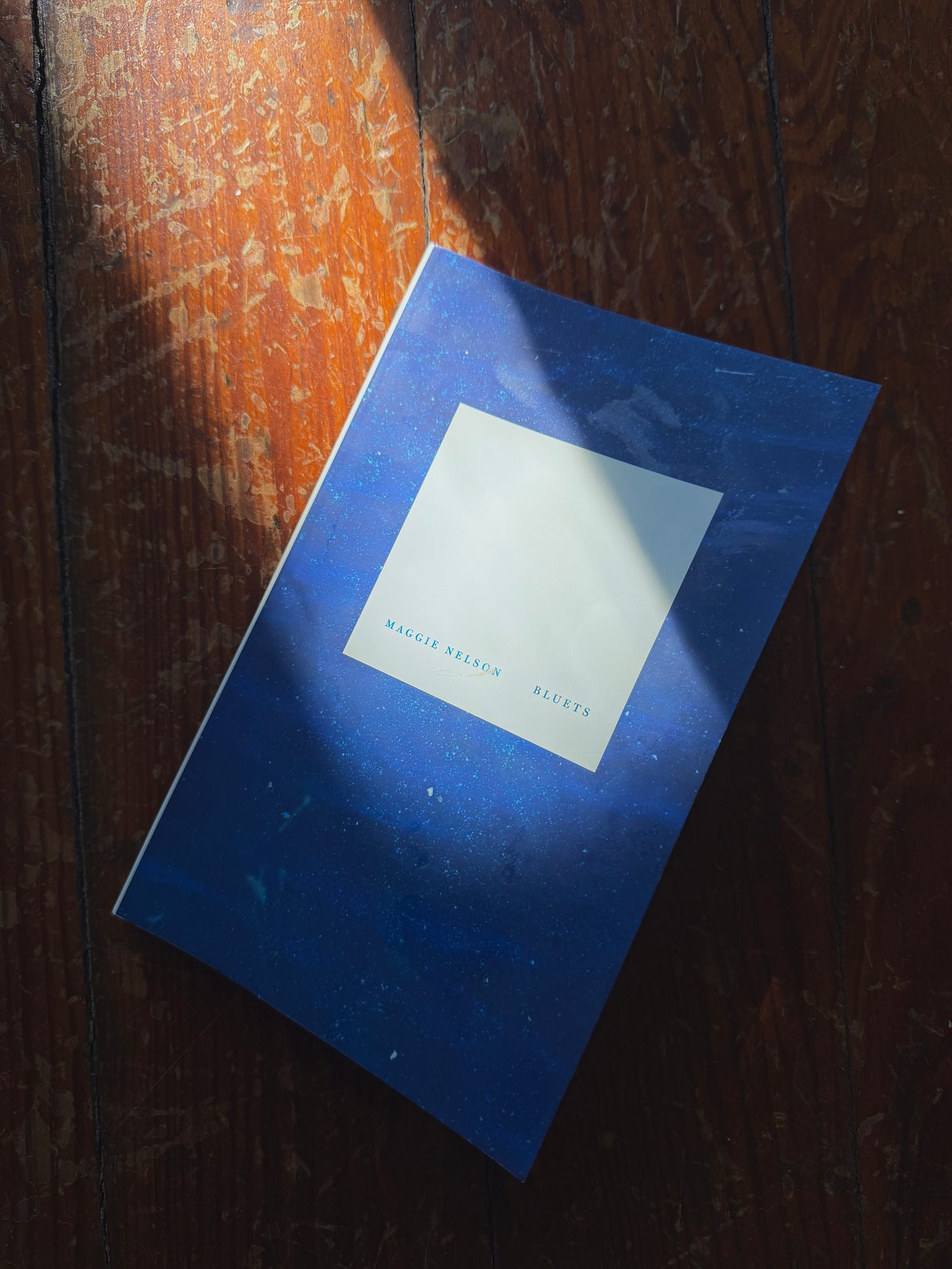‘Love is not consolation,’ she (Simone Weil) wrote. ‘It is light.’ All right then, let me try to rephrase. When I was alive, I aimed to be a student not of longing but of light.”
In Bluets—a raw, unflinching account of love and loss—Nelson creates a truly original work by refracting emotional assumptions through the lens of the color blue. As the opening quote reveals, this is an exploration of negotiating want and peace. It’s a journey of the heart that does not have to be precisely sexual; it can be platonic suffering or any situation in which one must reach for some light.
The book opens with Nelson’s suggestion that she’d fallen in love with a color: blue. And that love felt personal. She says it was “...as if falling under a spell, a spell I fought to stay under and get out from under, in turns.” This interplay between desire and grief is potent. The blue sightings help her crawl out of her depression as she feels her way forward: “It is, perhaps, my way of making my life feel ‘in progress’ rather than a sleeve of ash falling off a lit cigarette. One of the men asks, “Why blue?” People ask me this question often. I never know how to respond. We don’t get to choose what or whom we love, I want to say. We just don’t get to choose.”
Written in a hybrid style with stand-alone sentences, micrographs, and personal and researched context, it’s easy to consume this slim volume in an hour or two. This work explores sadness, certainly, but it’s on fire with life too; there is a magnetic quality to the swift bolts of text. Her sentences are stunningly beautiful in their depiction of mundane scraps of beauty and the shadows of desire witnessed by individual perspective:
“I walked around Brooklyn and noticed that the faded periwinkle of the abandoned Mobil gas station on the corner was suddenly blooming. In the baby-shit yellow showers at my gym, where snow sometimes fluttered in through the cracked gated windows, I noticed that the yellow paint was peeling in spots, and a decent, industrial blue was trying to creep in.”
Nelson herself dubbed her blue ideas as “propositions”, a sort of pre-Socratic philosophical fragment series. Johann Wolfgang von Goethe's Theory of Colours and Ludwig Wittgenstein's Remarks on Colour are particularly urgent sources of inspiration. Wittgenstein, in particular, wrote in short bursts that provide destabilization and intimacy with the reader, forcing them to think in tandem with him, inducing a “real-time” sensation. Nelson is no-holds-barred in her writing around sex, which only ignites the authority of her quest and brings forward some of her most exquisite capabilities:
“A warm afternoon in early spring, New York City. We went to the Chelsea Hotel to fuck. Afterward, from the window of our room, I watched a blue tarp on a roof across the way flap in the wind. You slept, so it was my secret. It was a smear of the quotidian, a bright blue flake amidst all the dank providence. It was the only time I came. It was essentially our lives. It was shaking.”
Bluets was written over three years while Nelson was in the throes of her doomed romance with a man in love with another woman. Simultaneously, she cared for her friend who’d become quadriplegic, a figure who evolves from a blue eye under gauze to a sage as she accesses the situation: “Eventually you will have to give up this love, she told me one night while I made us dinner. It has a morbid heart.” I love the friend’s use of the word eventually, a generosity of understanding that it’s not her journey but Nelson’s own.
Toward the end of Bluets, you feel Nelson grow as she reconciles, beyond desire, that she is ready to shore up for something more substantial:
“Perhaps it is becoming clearer why I felt no romance when you told me that you carried my last letter with you, everywhere you went, for months on end, unopened. This may have served some purpose for you, but whatever it was, surely it bore little resemblance to mine. I never aimed to give you a talisman, an empty vessel to flood with whatever longing, dread, or sorrow happened to be the day’s mood. I wrote it because I had something to say to you.”
While published in 2009, Bluets manages to be timeless with its arts and cultural references being iconic—Cornell, Emerson, Duras—rather than decade-driven, and the never-ending waves we mortals face in the thrashing sea of the heart. Naturally, she references Yves Klein, who invented and patented his shade of ultramarine called International Klein Blue. When she sees his blue paintings in person, she finds that up close, the sight is too much; she can’t feel it.
This book is not an utter tragedy, for, set against its love inquiry, it’s laced with self-deprecation, the sardonic critique of artistic funding, and the writing life. To be fair, romance is most beautifully written when it’s complex, not that I or anyone wants to live in that space for longer than required. There will always be lessons or life and art would fall flat. Still, one can hope we grow into stronger commanders of ourselves, seeking or finding, if you’re lucky, someone who will do the work alongside you so that a fresh, messy struggle comes, at the very least, with an additional set of warm arms. And, if not, if alone, one can hope to be such a good friend to oneself that growth is a source of pride rather than merely difficult.
Bluets was a phenomenon when it came out, at least in artistic circles, for its electric energy, its candor, and the reconsidering of conditioning factors threaded through our brains. Most media declare blue a hue of sadness. I do not associate blue with sadness; I find the condition of sadness colorless.
By definition, color is roughly a sensation of the eye based on how something or someone reflects and sends out light. Despair is honest, but it is not radiant. The noticing of tendrils of hue strewn across our walks, our bedroom windows, and the very clothes we put on our bodies is a claiming of light. May we all walk into color.




